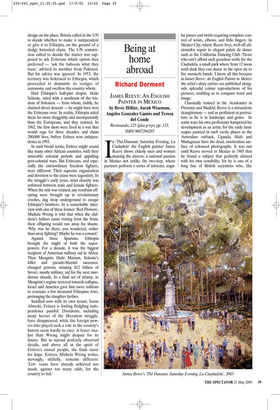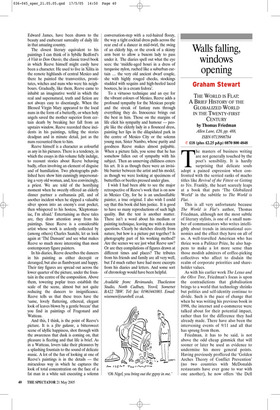Being at home abroad
Richard Dorment
JAMES REEVE: AN ENGLISH PAINTER IN MEXICO by Bevis Hillier, Sarah Wiseman, Angeles Gonzalez Gamio and Teresa del Conde Revimundo, £25 (plus p+p), pp. 125, ISBN 9687294205 In ‘Thé-Dansant; Saturday Evening, La Ciudadela’ the English painter James Reeve shows elderly men and women dancing the danzon, a national passion in Mexico not unlike the two-step, where partners perform a series of intricate, angu lar passes and twirls requiring complete control of wrists, elbows, and little fingers. In Mexico City, where Reeve lives, well-off aficionados repair to elegant palais de dance such as the California Dancing Club. Those who can’t afford such grandeur settle for the Ciudadela, a small park where from 12 noon until dusk they can dance in the open air to live mariachi bands. I know all this because in James Reeve: An English Painter in Mexico the artist’s diary entries are published alongside splendid colour reproductions of his pictures, enabling us to compare word and image.
Classically trained in the Academies in Florence and Madrid, Reeve is a miraculous draughtsman — and as proficient at portraiture as he is in landscape and genre. In some ways his own proficiency hampered his development as an artist, for the early landscapes painted in such exotic places as the Australian outback, Uganda, Haiti and Madagascar have the dead, emotionless surface of coloured photographs. It was not until Reeve moved to Mexico in 1985 that he found a subject that perfectly chimed with his own sensibility, for he is one of a long line of British eccentrics who, like Edward James, have been drawn to the beauty and exuberant surreality of daily life in that amazing country.
The closest literary equivalent to his paintings I can think of is Sybille Bedford’s A Visit to Don Otavio, the classic travel book in which Reeve himself might easily have been a character. He used to live in Xilita in the remote highlands of central Mexico and there he painted the transvestites, prostitutes, witches and nuns who were his neighbours. Gradually, like them, Reeve came to inhabit an imaginative world in which the real and supernatural, truth and fiction are not always easy to disentangle. When the Blessed Virgin Mary appeared to the local nuns in the form of a butterfly, or when holy angels saved the mother superior from certain death by breaking her fall from an upstairs window, Reeve recorded these incidents in his paintings, telling the stories deadpan and in minute detail, just as the nuns recounted them to him.
Reeve himself is a character as colourful as any in his pictures. There is a tendency, in which the essays in this volume fully indulge, to recount stories about Reeve behaving badly, often involving an element of disguise and of humiliation. Two photographs published here show him cunningly impersonating a very old woman, and, less convincingly, a priest. We are told of the horrifying moment when he sweetly offered an elderly dinner partner a euthanasia pill, and of another incident when he slipped a valuable silver spoon into an enemy’s coat pocket, then whispered to his hostess, ‘Kleptomaniac, I’m afraid.’ Entertaining as these tales are, they draw attention away from his paintings. Since Reeve is a considerable artist whose work is ardently collected by (among others) Charles Saatchi, let us look again at ‘Thé Dansant’ and see what makes Reeve so much more interesting than most contemporary figure painters.
In his diaries, Reeve describes the dancers in his painting as either decrepit or deranged, but also as flamboyant and happy. Their tiny figures are spread out across the lower quarter of the picture, under the fountain in the centre of the composition. Above them, towering poplar trees establish the scale of the scene, almost but not quite reducing the dancers to insignificance. Reeve tells us that these trees have the ‘same, lovely fluttering, ethereal, elegant look of leaves blown by a gentle breeze’ that you find in paintings of Fragonard and Watteau.
And this, I think, is the point of Reeve’s picture. It is a fête galante, a bittersweet scene of idyllic happiness, shot through with the awareness that dusk is coming on, that pleasure is fleeting and that life is brief. As in a Watteau, lovers take their pleasures by a splashing fountain to the sound of delicate music. A lot of the fun of looking at one of Reeve’s paintings is in the details — the miraculous way in which he captures the look of total concentration on the face of a fat man in a white suit executing a solemn conversation-step with a red-haired floozy, the way a tight cocktail dress pulls across the rear end of a dancer in mid-twirl, the swing of an elderly hip, or the crook of a skinny arm bent to allow a buxom lady to pass under it. The diaries spell out what the eye sees: the ‘middle-aged houri in a dress of turquoise nylon, ruched like a suburban curtain ... the very old ancient dwarf couple, she with highly rouged cheeks, stockings studded with sequins and high-heeled laced bootees, he in a cream fedora’.
To a virtuoso technique and an eye for the vibrant colours of Mexico, Reeve adds a profound sympathy for the Mexican people and the streak of fantasy runs through everything they do. Innocence brings out the best in him. Those on the margins of life elicit his sympathy and humour — people like the elderly lady in a flounced dress, painting her lips in the dilapidated park in the centre of Mexico City or the solemn young nun, Sister Nambo, whose purity and goodness Reeve makes almost palpable. When a picture fails, you sense that he has somehow fallen out of sympathy with his subject. Then an unnerving chilliness enters his art. It is as though there were an invisible barrier between the artist and his model, as though we were looking at specimens of butterflies or beetles pressed under glass.
I wish I had been able to see the major retrospective of Reeve’s work that is on now in Mexico City, for he is an unclassifiable painter, a true original. I also wish I could say that this book did him justice. It is good to have so many reproductions of such high quality. But the text is another matter. There isn’t a word about his medium or painting technique, leaving me with a dozen questions. Clearly he sketches directly from nature, but how is a picture put together? Is photography part of his working method? Are the scenes we see just what Reeve saw? Or are they compilations of figures drawn at different times and places? The tributes from his friends and family are all very well, but I’d much rather have had more excerpts from his diaries and letters. And some sort of chronology would have been helpful.


























































 Previous page
Previous page